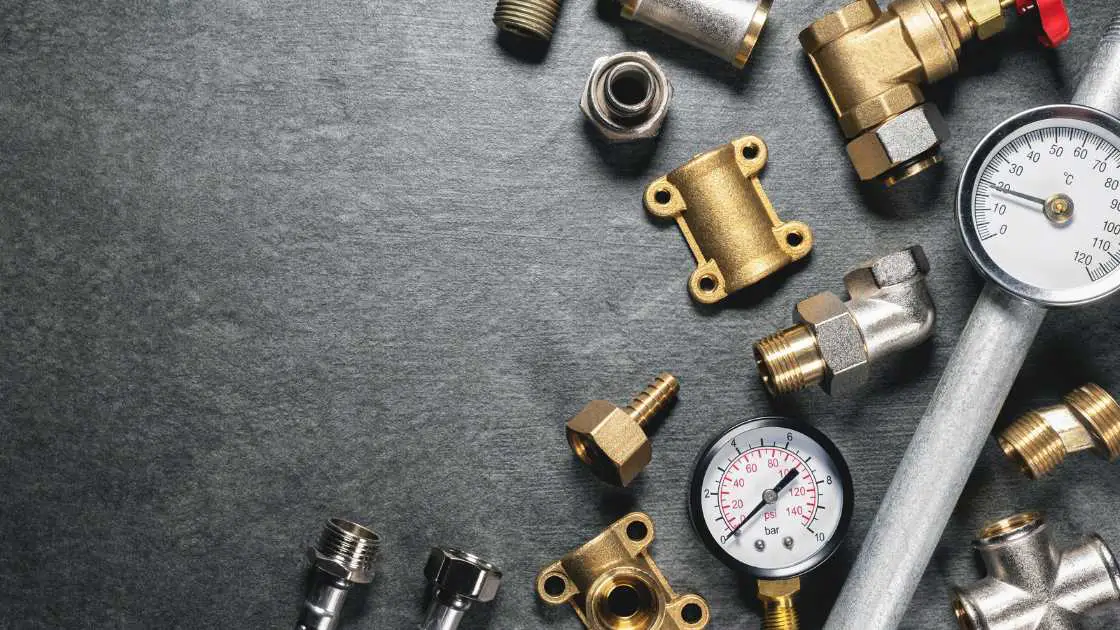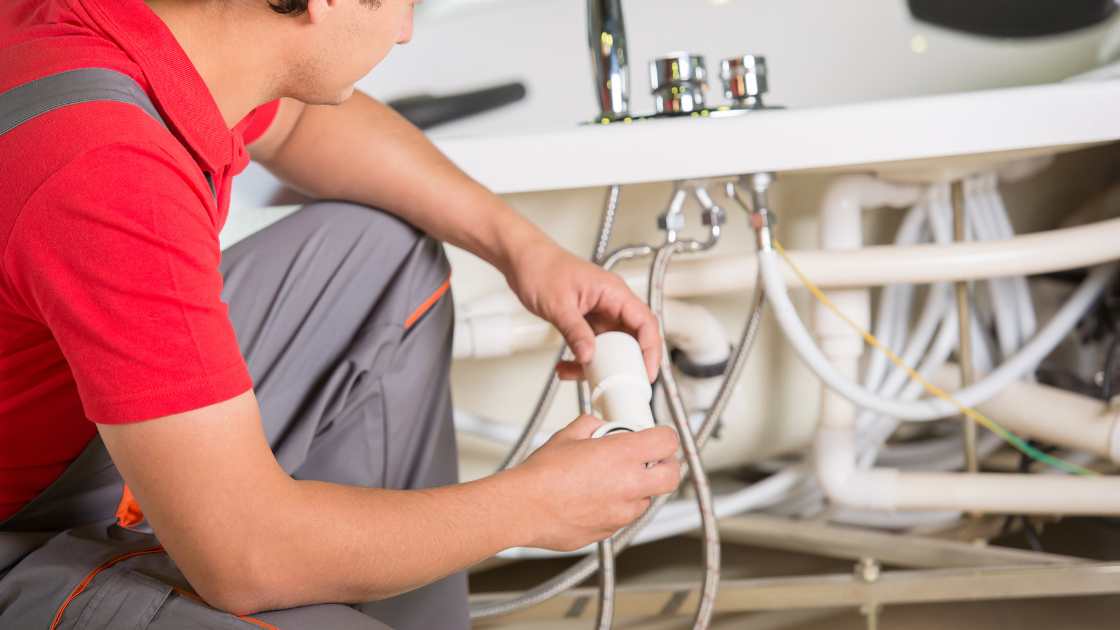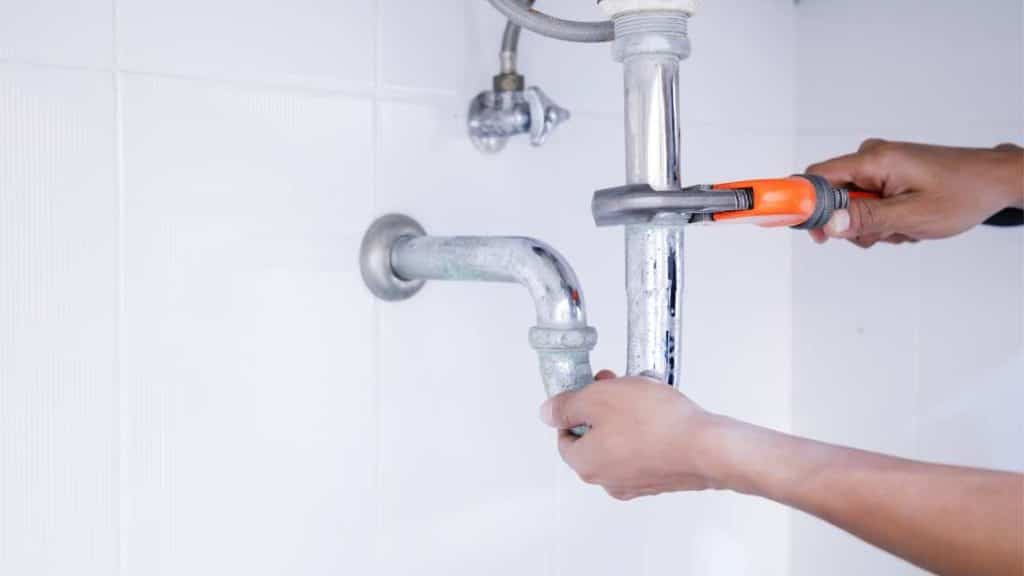To make a plumbing snake turn corners, slowly rotate it while applying gentle forward pressure. Guide the snake carefully to navigate bends in the pipes.
Dealing with clogged drains can be a challenging endeavor, especially when the blockage is beyond a straight pipe’s reach.
Enter the plumbing snake, a flexible and handy tool that enables you to tackle these issues head-on. Known also as a “drain auger,” this tool is essential for any DIY plumbing toolkit.
Mastering its use requires technique of maneuvering it through the twists and turns of your plumbing.
Whether you’re a homeowner or a budding handy-person, knowing how to effectively navigate a plumbing snake through the intricate corners of your pipes can save you time, money, and the inconvenience of persistent blockages.
Now , We will explain in here about “How to Make a Plumbing Snake Turn Corners?”
This skill is not only practical but can also prevent potential damage to your pipes that might arise from improper use of plumbing tools.
Introduction To Plumbing Snakes
Plumbing snakes, also known as drain snakes, are essential tools for anyone facing clogged drains. These handy devices break up blockages and navigate through pipes to restore proper water flow. In this post, we unveil the mystery behind plumbing snakes and provide tips on how they masterfully turn corners.
The Role Of Plumbing Snakes
Imagine you’re on a treasure hunt inside your pipes—the plumbing snake is your map to treasure. Instead of gold, the prize is a clear drain. It works by entering the drain and moving through pipes until it reaches the clog.
With a bit of skill, you can make the snake twist, turn, and even break down the obstacle. Let’s dive into how these tools keep our pipes flowing.
Different Types Of Plumbing Snakes
Different jobs require different tools, and plumbing snakes are no exception.
- Hand Augers: Ideal for simple sink clogs, these manual snakes turn with a handle.
- Closet Augers: Specifically designed for toilets, they prevent scratches and reach deep.
- Drum Augers: Suited for more complex issues, they clear bigger drains.
- Motorized Drain Snakes: For the toughest jobs, these offer power and precision.
Selecting the right type of snake for the job is critical for success and can save you time and effort.
The Mechanics Of A Plumbing Snake
A plumbing snake works is key to mastering its use. A plumbing snake, or drain auger, maneuvers through pipes, helping clear tough clogs. The secret to its success lies in the balance between flexibility and strength. Let’s delve into its anatomy and capabilities.
Anatomy Of A Plumbing Snake

The construction of a plumbing snake is straightforward, yet ingenious. Key components allow it to navigate pipes. These include:
- The Cable: A long, flexible coil that pushes through bends.
- The Handle: Offers grip and control when turning.
- The Clog Breaker: The tip piece designed to pierce debris.
The Flexibility And Rigidity Balance
A plumbing snake must twist and push with precision. To turn corners efficiently, it needs to be flexible enough to navigate the twists and turns of your pipes, yet rigid enough to apply force to the clog. Finding the right tool involves assessing your pipe’s diameter, length, and the types of bends it includes.
| Feature | Function |
|---|---|
| Flexibility | Conforms to pipe curves and corners. |
| Rigidity | Forces through obstructions effectively. |
With proper technique, turning the snake around tight corners is possible. The key lies in gentle rotations and steady pressure. As you gain familiarity, you’ll learn to feel resistance and respond with maneuvers that tackle it head-on.
Preparing To Navigate Corners
Preparing to Navigate Corners in your home’s plumbing system is like guiding a friend through a maze; careful planning ensures a smooth journey. When a clog eludes a straight shot from your trusty plunger or drain cleaner, a plumbing snake becomes the go-to solution.
Yet, its effectivity hinges on its ability to maneuver the twists and turns of your pipes. Let’s equip you with the knowledge to master this serpentine tool.
Assessing Your Plumbing Layout
Know your battlefield before engaging. Your plumbing layout is a roadmap; it is important. Here’s a clear path to do so:
- Locate cleanouts for a direct access point to the clog.
- Consult your home’s blueprints for a visual on sink, toilet, and sewer line connections.
- Measure the distance to the clog if possible.
- Note the number and sharpness of corners to predict the snake’s path.
Use these insights to plan your approach, making the next steps more instinctive.
Choosing The Right Snake For Your Pipes
Selecting a fitting snake is key to conquering corners. Here are succinct steps to follow:
- Determine the diameter of your pipes—smaller pipes require a more flexible snake.
- Pick a length that’s adequate for reaching the clog.
- Opt for a snake with an adjustable head to navigate bends with ease.
- Consider a camera-equipped snake for real-time visuals within your pipes.
Match the snake to the complexity of your plumbing for an effective clog-clearing crusade.
Techniques To Make A Snake Turn Corners

Clearing clogs in a plumbing system often requires navigating the twist and turns of pipes. A plumbing snake, also known as a drain auger, becomes an essential tool.
Mastering the skill of navigating a snake through tight corners can mean the success of clearing a blockage or avoiding plumbing problems. Mastery of this skill ensures both the effectiveness and safety of the cleaning process.
The Importance Of Proper Technique
Mastering the art of turning corners with a plumbing snake is vital. It ensures that pipes remain intact and the tool reaches deep clogs effectively. Precise movements and controlled force help to move smoothly through bends, avoiding pipe damage that can lead to leaks or other issues.
Step-by-step Guide To Guiding The Snake
- Prepare the area: Clear the workspace and have gloves and goggles ready for safety.
- Insert the snake: Gently feed the head of the snake into the drain until resistance is felt.
- Approach the turn: When resistance occurs, you’ve likely reached a corner.
- Use a gentle, twisting motion: Rotate the snake’s handle slowly to help the head navigate the corner.
- Advance with care: Push and twist simultaneously, feeling for the moment the snake edges past the turn.
- Continue feeding snake: Once past the corner, continue moving it forward till you reach the clog.
- Retract smoothly: After clearing the clog, retract the snake with as much caution as when it was inserted.
Handling a plumbing snake with precision takes practice. Regular maintenance and proper technique reduce the risk of plumbing headaches down the road. Use these steps as a guide to aid in efficient, safe drain cleaning.
Common Challenges In Corner Navigation
Navigating plumbing snakes around corners presents unique difficulties. Pipes are not always straight, and turns can be sharp. A successful clearing operation relies on overcoming these challenges. Let’s delve into the intricacies of corner navigation, identifying obstructive configurations, and mastering tight bends.
Identifying Obstructive Pipe Configurations
Your pipes is touchy. Some common obstructions include:
- Sharp angles: They can halt a snake’s progress.
- Multiple bends: These create complex pathways.
- Narrow pipes: Limited space can prevent easy movement.
Use a pipe diagram or a plumbing blueprint to anticipate challenges. Such preparation allows for more effective snaking.
Handling Tight Bends And Stubborn Blockages
Tight bends demand patience and the right technique. To overcome them:
- Start with a smaller head on your snake.
- Rotate the snake slowly as it approaches the bend.
- Apply gentle pressure to ease the snake around the corner.
Stubborn blockages sometimes require multiple attempts. Switching to a different snake head can offer better results. Combine this with a persistence and a strategic approach for successful clearance.
Troubleshooting Tips For Difficult Angles
Dealing with difficult angles while snaking a drain can be challenging. Plumbing snakes, also known as drain augers, are essential for clearing clogs. But what happens when you hit a tricky corner? These troubleshooting tips help in mastering the twists and turns of drain plumbing.
Adjusting Your Approach Mid-snake
Patience is key when a plumbing snake faces a tough corner. Follow these steps:
- Slowly feed the snake until resistance is felt.
- Gently rotate the handle and push simultaneously.
- If the snake stops, pull back slightly.
- Apply constant, mild pressure to advance the snake.
Maintain a steady pace and let the tool work its way through the curve.
When And How To Use A Retrieving Auger
A retrieving auger is a specialist tool for difficult obstructions:
- Use when regular snakes fail to remove the clog.
- Insert the auger until it reaches the blockage.
- Twist the handle to grab onto the debris.
- Pull the auger back to retrieve the obstruction.
This tool is excellent for grabs and retrieves objects that are causing a blockage.
Advanced Techniques And Tools
Tackling plumbing issues gets tricky with tight corners. A traditional plumbing snake might do the job for simple clogs, but what about the bends and turns of complex piping systems?
Fear not, as advanced techniques and tools are here to make the process smoother.
Whether you are a professional plumber or a DIY enthusiast, these methods will help your snake navigate those pesky corners with ease.
Using A Camera For Visual Aid
A camera provides real-time visuals of the pipe’s interior. This makes it easier to understand the blockage’s location. Moreover, a camera helps in assessing the angle and severity of the pipe’s bend.
- Insert the camera before the snake.
- Adjust the snake’s direction based on live feedback.
Specialized Attachments For Tough Corners
Attachments enhance the snake’s flexibility. For difficult corners, attachments such as cutting heads or C-cutter blades are essential.
| Attachment Type | Use Case |
|---|---|
| Drop Head | Slides easier around tight bends. |
| C-Cutter | Cleans wider sections in a single pass. |
| Grease Cutter | Battles grease and sludge build-up. |
To effectively use these attachments:
- Choose an attachment fit for the obstruction type.
- Connect it securely to the snake.
- Feed the snake carefully, turning it as you push forward.
Safety Considerations And Best Practices
Working with a plumbing snake requires care. Ensuring safety helps avoid accidents and damage. Follow these tips for safe and effective use.
Protective Gear And Safe Handling

Before you begin, gear up for safety. Gloves and goggles are a must. They protect your hands and eyes from debris. Long sleeves prevent scrapes.
- Gloves: Wear heavy-duty gloves to keep hands safe from sharp objects.
- Goggles: Protect your eyes from dirt and possible splashes.
- Long sleeves: Shield arms from scratches.
Handle the plumbing snake with care. Start slowly. Increase pressure if needed. When you reach a corner, ease up. Let the tool work its way through.
Maintaining Your Plumbing Snake
Regular maintenance extends the life of your plumbing snake. Clean and store it properly.
| Task | Frequency | Details |
|---|---|---|
| Cleaning | After each use | Rinse and dry to prevent rust. |
| Inspection | Monthly | Check for damage or kinks. |
| Lubrication | Every 6 months | Apply oil to keep it moving smoothly. |
Store your plumbing snake in a cool, dry place. Hang it up to prevent coiling issues. Stay organized for the next use.
When To Call A Professional
Attempting to maneuver a plumbing snake through complex pipe bends can be daunting. Knowing when to seek expert assistance is necessary for both your plumbing’s integrity and your safety. The following sections outline scenarios where professional intervention is the smart choice.
Recognizing When You’re Out Of Your Depth
Struggling with a plumbing snake often indicates a situation best left to professionals. Complex blockages or concerns about causing pipe damage mean it’s time to step back and call an expert. Below are clear signs that you need professional help:
- Snake refuses to turn corners after multiple attempts
- Visible pipe damage or unusual pipe layouts
- Recurring clogs even after snaking
- Lack of proper tools or experience for the job
The Benefits Of Professional Plumbing Services

Professional plumbers not only resolve immediate issues but they also prevent future problems. Here’s why their expertise matters:
| Benefit | Explanation |
|---|---|
| Expertise | Years of experience and training enable professional plumbers to tackle plumbing challenges effectively. |
| Tools | Advanced equipment helps navigate tough corners and remove blockages with precision. |
| Efficiency | Professional services mean quick problem identification and resolution, saving you time and hassle. |
| Safety | Professionals know how to manage complex plumbing tasks safely, preventing personal injury and property damage. |
| Guarantee | Work often comes with a guarantee, giving you peace of mind and protection against future issues. |
Add further content to your post as necessary without linking phrases
Mastering The Turn
Mastering the turn with a plumbing snake is pivotal for navigating complex pipe networks. With precise control and technique, conquering corners becomes a breeze, streamlining your plumbing tasks.
Navigating a plumbing snake through pipes with sharp corners can feel tricky. But with practice, anyone can become skilled at this important aspect of DIY plumbing.
Recap Of Key Takeaways
Mastering a plumbing snake involves its mechanics and how it moves through pipes. It’s essential to remember these points:
- Approach corners slowly to maintain control.
- Keep pressure steady and twist the snake as it turns.
- Advance the snake inch by inch to prevent kinks.
The Journey To Becoming A Plumbing Snake Pro
Transforming into a plumbing snake pro doesn’t happen overnight. It’s a journey that includes:
- Getting to know your tools.
- Regular practice.
- Learning from each experience.
Patience is key. Even seasoned pros need time to perfect their technique. Keep at it, and soon, tight corners will be no match for your skills.
Frequently Asked Questions On How To Make A Plumbing Snake Turn Corners
Can Plumbing Snakes Navigate Pipe Bends?
Plumbing snakes can navigate through bends and elbows in pipes. However, the flexibility of the snake and the technique used are critical factors. Slowly twisting the handle while applying gentle forward pressure helps the snake turn corners effectively.
What Helps Plumbing Snakes Turn Corners?
To help a plumbing snake turn corners, apply steady, light pressure while rotating the handle. This assists the flexible cable in navigating through bends. The snake’s design allows it to flex and twist through pipes.
How Do You Guide A Snake Through Tight Curves?
Guiding a snake through tight curves requires a careful balance of pressure and movement. Start by slowly feeding the snake into the pipe. As resistance is met, gently rotate the handle and push slightly to help the cable bend.
Are There Tips For Using Plumbing Snakes In Awkward Pipes?
For awkward pipes, start with the smallest snake that fits to reduce resistance. Use a hand-cranked snake for better control in tight spots. Slow, incremental movements help the snake work through tight bends and avoid getting stuck.
Conclusion
Mastering the art of navigating a plumbing snake through the challenging twists and turns of your pipes is essential. With the practical tips discussed, you’ll tackle those corners with confidence. Remember, patience and practice are your best tools. For smooth, unclogged pipes, keep these pointers in hand and turn those tricky corners like a pro.

